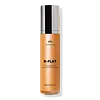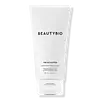What's inside
What's inside
 Key Ingredients
Key Ingredients

 Benefits
Benefits

 Concerns
Concerns

 Ingredients Side-by-side
Ingredients Side-by-side

Water
Skin ConditioningHydrogenated Polyisobutene
EmollientGlycerin
HumectantC12-15 Alkyl Benzoate
AntimicrobialStearyl Alcohol
EmollientCaprylic/Capric Triglyceride
MaskingAcrylates Copolymer
Cetyl Alcohol
EmollientDimethicone
EmollientSqualane
EmollientButyrospermum Parkii Butter
Skin ConditioningTheobroma Cacao Seed Butter
EmollientTocopheryl Acetate
AntioxidantSodium Hyaluronate
HumectantBentonite
AbsorbentPropylene Glycol
HumectantButylene Glycol
HumectantBisabolol
MaskingPaullinia Cupana Fruit Extract
Skin ConditioningSchinus Terebinthifolia Seed Extract
AstringentPersea Gratissima Fruit Extract
EmollientButyrospermum Parkii Butter Extract
Skin ConditioningTriticum Vulgare Germ Oil
EmollientEthylhexylglycerin
Skin ConditioningCeteareth-20
CleansingPhenoxyethanol
PreservativeVanillyl Butyl Ether
MaskingChlorphenesin
AntimicrobialSodium Hydroxide
BufferingSodium Carbonate
BufferingParfum
MaskingGeraniol
PerfumingHexyl Cinnamal
PerfumingLinalool
PerfumingCI 15985
Cosmetic ColorantCI 19140
Cosmetic ColorantCI 17200
Cosmetic ColorantWater, Hydrogenated Polyisobutene, Glycerin, C12-15 Alkyl Benzoate, Stearyl Alcohol, Caprylic/Capric Triglyceride, Acrylates Copolymer, Cetyl Alcohol, Dimethicone, Squalane, Butyrospermum Parkii Butter, Theobroma Cacao Seed Butter, Tocopheryl Acetate, Sodium Hyaluronate, Bentonite, Propylene Glycol, Butylene Glycol, Bisabolol, Paullinia Cupana Fruit Extract, Schinus Terebinthifolia Seed Extract, Persea Gratissima Fruit Extract, Butyrospermum Parkii Butter Extract, Triticum Vulgare Germ Oil, Ethylhexylglycerin, Ceteareth-20, Phenoxyethanol, Vanillyl Butyl Ether, Chlorphenesin, Sodium Hydroxide, Sodium Carbonate, Parfum, Geraniol, Hexyl Cinnamal, Linalool, CI 15985, CI 19140, CI 17200
Water
Skin ConditioningCaprylic/Capric Triglyceride
MaskingC15-19 Alkane
SolventCetearyl Alcohol
EmollientEthylhexyl Palmitate
EmollientC14-22 Alcohols
Emulsion StabilisingButylene Glycol
HumectantHydroxyethyl Acrylate/Sodium Acryloyldimethyl Taurate Copolymer
Emulsion StabilisingGlycerin
HumectantAloe Barbadensis Leaf Juice
Skin ConditioningBupleurum Falcatum Root Extract
Skin ConditioningBougainvillea Spectabilis Leaf Cell Extract
AntioxidantSphacelaria Scoparia Extract
AntimicrobialCamellia Sinensis Seed Oil
HumectantSpirulina Platensis Powder
Skin ProtectingSodium Phytate
Sodium Lauroyl Glutamate
Arginine
MaskingXylitylglucoside
HumectantDipalmitoyl Hydroxyproline
Skin ConditioningC12-20 Alkyl Glucoside
EmulsifyingEthylhexylglycerin
Skin ConditioningPanthenol
Skin ConditioningTocopheryl Acetate
AntioxidantCaffeine
Skin ConditioningCoenzyme A
Skin ConditioningBiotin
AntiseborrhoeicCetearyl Glucoside
EmulsifyingSorbitan Isostearate
EmulsifyingAnhydroxylitol
HumectantGlucose
HumectantXylitol
HumectantPEG-8
HumectantXanthan Gum
EmulsifyingPolysorbate 60
EmulsifyingParfum
MaskingAlcohol
AntimicrobialPhenoxyethanol
PreservativePalmitic Acid
EmollientAscorbic Acid
AntioxidantSodium Benzoate
MaskingCitric Acid
BufferingPotassium Sorbate
PreservativeBenzyl Salicylate
PerfumingHexyl Cinnamal
PerfumingHydroxycitronellal
PerfumingLimonene
PerfumingLinalool
PerfumingWater, Caprylic/Capric Triglyceride, C15-19 Alkane, Cetearyl Alcohol, Ethylhexyl Palmitate, C14-22 Alcohols, Butylene Glycol, Hydroxyethyl Acrylate/Sodium Acryloyldimethyl Taurate Copolymer, Glycerin, Aloe Barbadensis Leaf Juice, Bupleurum Falcatum Root Extract, Bougainvillea Spectabilis Leaf Cell Extract, Sphacelaria Scoparia Extract, Camellia Sinensis Seed Oil, Spirulina Platensis Powder, Sodium Phytate, Sodium Lauroyl Glutamate, Arginine, Xylitylglucoside, Dipalmitoyl Hydroxyproline, C12-20 Alkyl Glucoside, Ethylhexylglycerin, Panthenol, Tocopheryl Acetate, Caffeine, Coenzyme A, Biotin, Cetearyl Glucoside, Sorbitan Isostearate, Anhydroxylitol, Glucose, Xylitol, PEG-8, Xanthan Gum, Polysorbate 60, Parfum, Alcohol, Phenoxyethanol, Palmitic Acid, Ascorbic Acid, Sodium Benzoate, Citric Acid, Potassium Sorbate, Benzyl Salicylate, Hexyl Cinnamal, Hydroxycitronellal, Limonene, Linalool
Ingredients Explained
These ingredients are found in both products.
Ingredients higher up in an ingredient list are typically present in a larger amount.
Butylene Glycol (or BG) is used within cosmetic products for a few different reasons:
Overall, Butylene Glycol is a safe and well-rounded ingredient that works well with other ingredients.
Though this ingredient works well with most skin types, some people with sensitive skin may experience a reaction such as allergic rashes, closed comedones, or itchiness.
Learn more about Butylene GlycolThis ingredient is an emollient, solvent, and texture enhancer. It is considered a skin-softener by helping the skin prevent moisture loss.
It helps thicken a product's formula and makes it easier to spread by dissolving clumping compounds.
Caprylic Triglyceride is made by combining glycerin with coconut oil, forming a clear liquid.
While there is an assumption Caprylic Triglyceride can clog pores due to it being derived from coconut oil, there is no research supporting this.
Learn more about Caprylic/Capric TriglycerideEthylhexylglycerin (we can't pronounce this either) is commonly used as a preservative and skin softener. It is derived from glyceryl.
You might see Ethylhexylglycerin often paired with other preservatives such as phenoxyethanol. Ethylhexylglycerin has been found to increase the effectiveness of these other preservatives.
Glycerin is already naturally found in your skin. It helps moisturize and protect your skin.
A study from 2016 found glycerin to be more effective as a humectant than AHAs and hyaluronic acid.
As a humectant, it helps the skin stay hydrated by pulling moisture to your skin. The low molecular weight of glycerin allows it to pull moisture into the deeper layers of your skin.
Hydrated skin improves your skin barrier; Your skin barrier helps protect against irritants and bacteria.
Glycerin has also been found to have antimicrobial and antiviral properties. Due to these properties, glycerin is often used in wound and burn treatments.
In cosmetics, glycerin is usually derived from plants such as soybean or palm. However, it can also be sourced from animals, such as tallow or animal fat.
This ingredient is organic, colorless, odorless, and non-toxic.
Glycerin is the name for this ingredient in American English. British English uses Glycerol/Glycerine.
Learn more about GlycerinHexyl Cinnamal is a fragrance ingredient with a similar scent to jasmine. It can be naturally found in chamomile essential oil.
This ingredient is a known EU allergen and may sensitize the skin. The EU requires this ingredient to be listed separately on an ingredients list.
Hexyl Cinnamal is not water soluble but is soluble in oils.
Learn more about Hexyl CinnamalLinalool is a fragrance and helps add scent to products. It's derived from common plants such as cinnamon, mint, citrus, and lavender.
Like Limonene, this ingredient oxidizes when exposed to air. Oxidized linalool can cause allergies and skin sensitivity.
This ingredient has a scent that is floral, spicy tropical, and citrus-like.
Learn more about LinaloolParfum is a catch-all term for an ingredient or more that is used to give a scent to products.
Also called "fragrance", this ingredient can be a blend of hundreds of chemicals or plant oils. This means every product with "fragrance" or "parfum" in the ingredients list is a different mixture.
For instance, Habanolide is a proprietary trade name for a specific aroma chemical. When used as a fragrance ingredient in cosmetics, most aroma chemicals fall under the broad labeling category of “FRAGRANCE” or “PARFUM” according to EU and US regulations.
The term 'parfum' or 'fragrance' is not regulated in many countries. In many cases, it is up to the brand to define this term.
For instance, many brands choose to label themselves as "fragrance-free" because they are not using synthetic fragrances. However, their products may still contain ingredients such as essential oils that are considered a fragrance by INCI standards.
One example is Calendula flower extract. Calendula is an essential oil that still imparts a scent or 'fragrance'.
Depending on the blend, the ingredients in the mixture can cause allergies and sensitivities on the skin. Some ingredients that are known EU allergens include linalool and citronellol.
Parfum can also be used to mask or cover an unpleasant scent.
The bottom line is: not all fragrances/parfum/ingredients are created equally. If you are worried about fragrances, we recommend taking a closer look at an ingredient. And of course, we always recommend speaking with a professional.
Learn more about ParfumPhenoxyethanol is a preservative that has germicide, antimicrobial, and aromatic properties. Studies show that phenoxyethanol can prevent microbial growth. By itself, it has a scent that is similar to that of a rose.
It's often used in formulations along with Caprylyl Glycol to preserve the shelf life of products.
Tocopheryl Acetate is AKA Vitamin E. It is an antioxidant and protects your skin from free radicals. Free radicals damage the skin by breaking down collagen.
One study found using Tocopheryl Acetate with Vitamin C decreased the number of sunburned cells.
Tocopheryl Acetate is commonly found in both skincare and dietary supplements.
Learn more about Tocopheryl AcetateWater. It's the most common cosmetic ingredient of all. You'll usually see it at the top of ingredient lists, meaning that it makes up the largest part of the product.
So why is it so popular? Water most often acts as a solvent - this means that it helps dissolve other ingredients into the formulation.
You'll also recognize water as that liquid we all need to stay alive. If you see this, drink a glass of water. Stay hydrated!
Learn more about Water